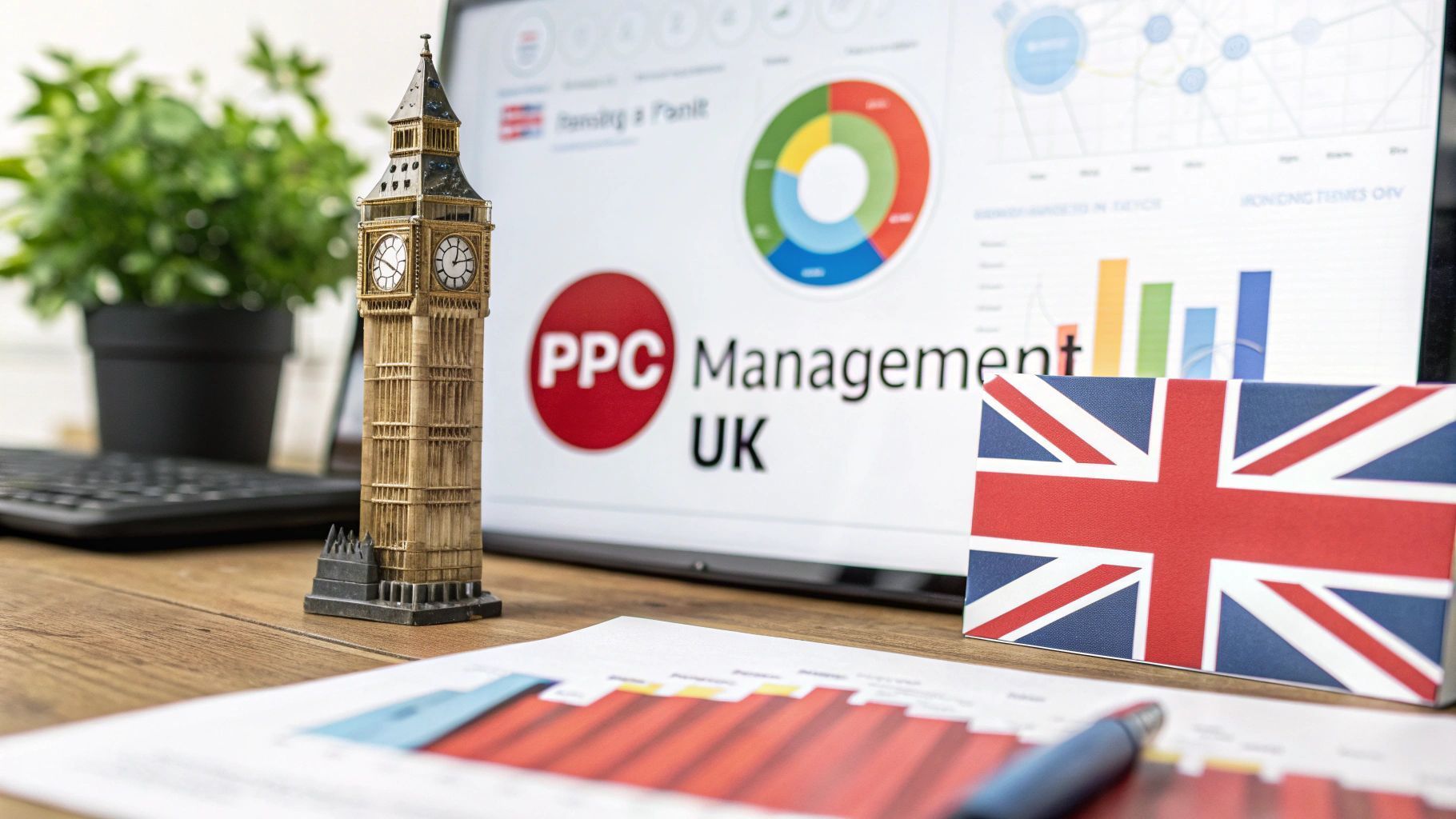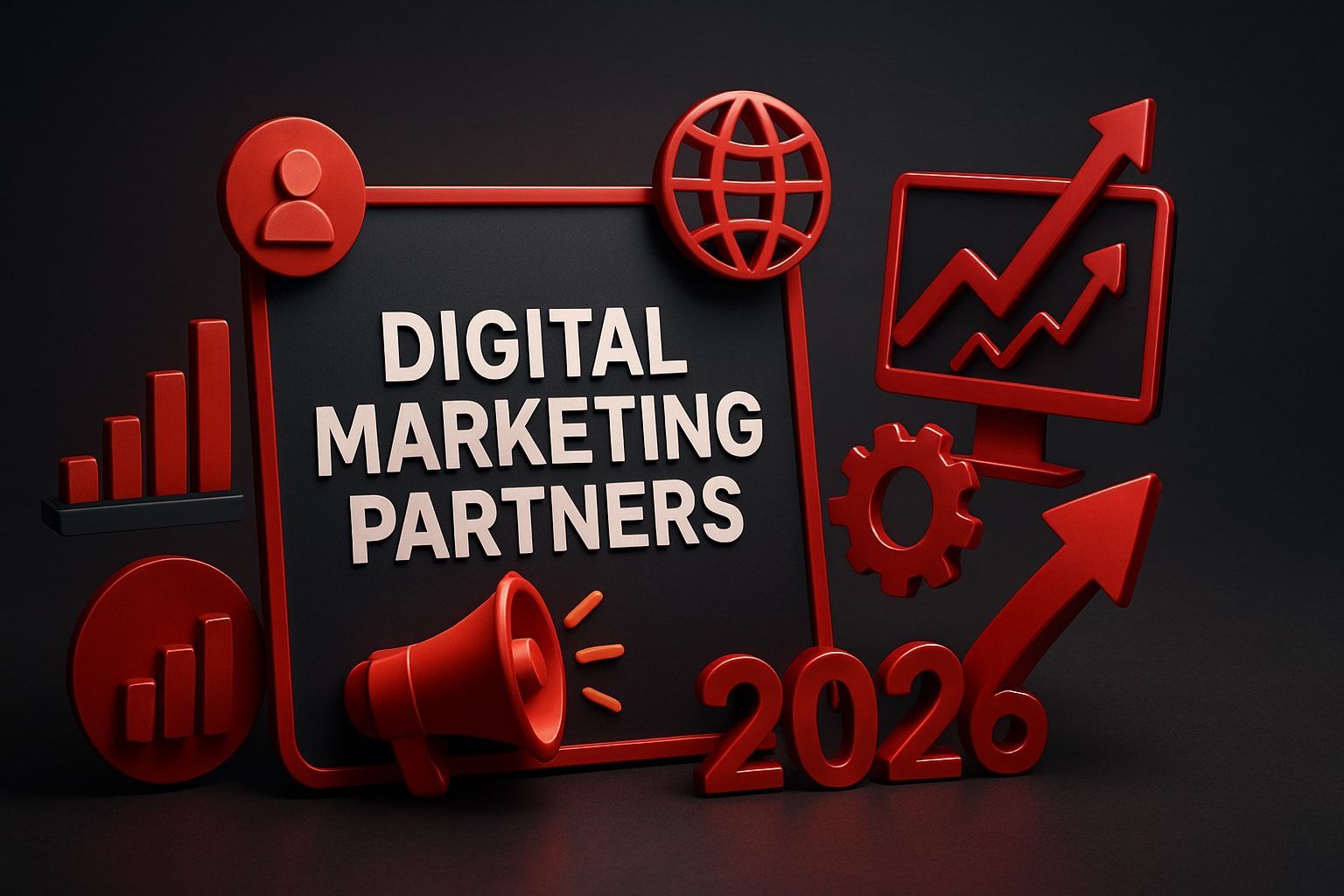Sponsorship motorsport: How to win partners & funding
Motorsport sponsorship is a powerful game. At its heart, it’s a marketing partnership where a business backs a team or driver, financially or with products, in exchange for high-octane brand exposure. The race car becomes a moving billboard, the driver a brand ambassador and the whole operation a platform for generating a return that leaves traditional advertising in the dust. It's an alliance built on shared audiences and a mutual drive to win.
Building Your Foundation for Sponsorship
Before you even think about approaching a potential partner, you need to know exactly what you’re selling. Securing sponsorship isn't just about being quick on the track; it’s about presenting a bulletproof commercial package. Getting this groundwork right is what separates the teams begging for funding from those offering a genuine investment opportunity.
Define Your Brand and Story
Your brand is your identity. It’s the story you tell, the values you stand for and the connection you forge with your fans. A strong brand narrative gives a potential sponsor something to believe in—something that will click with their own customers.
Are you the underdog defying the odds? The technically obsessed engineering outfit? Or the family-run team with a legacy to uphold? This story is your unique selling point. It’s what makes you different from every other team in the paddock chasing the same sponsorship money.
A compelling brand story is the hook. It's not about what you do (race cars) but why you do it. This narrative is often what sticks in a sponsor's mind, long after they've forgotten the stats on a page.
Your story needs to be baked into everything you do, from your social media content to your car's livery. It must be authentic and consistent.
Pinpoint Your Audience with Precision
"Who are your followers?" It's one of the first questions a sponsor will ask. You need to get past vague answers and dig into the hard data. Knowing your audience inside-out lets you find sponsors who are desperately trying to reach those very same people.
Start by getting forensic with your follower analysis:
- Demographics: What’s their average age, gender, location and income?
- Interests: What other sports, hobbies or brands do they follow?
- Behaviour: What do they buy? Where do they shop? What content gets them fired up?
This level of detail is gold. If you can prove your audience is packed with high-earning tech professionals aged 30-50 , you suddenly become a perfect match for luxury car brands, financial services or premium tech companies. For a deeper dive, you can discover more about building a strong brand in the UK motorsport sector and how it pulls in the right partners.
Conduct an Honest Asset Assessment
Finally, you need a complete inventory of every single thing you can offer a sponsor. Think of it as your sponsorship "stock list". It needs to be exhaustive, going way beyond just a logo on the car.
Map out everything you have to offer:
- Physical Assets: Branding space on the race car, driver suit, team kit, transporter and pit garage.
- Digital Assets: Your website traffic, social media numbers, engagement rates (likes, shares, comments) and your email list.
- Experiential Assets: The juicy stuff. Think trackside hospitality, driver appearances, show car displays at corporate HQs or "money-can't-buy" experiences like a passenger hot lap.
Every one of these items has a commercial value. By getting a firm grip on your brand, your audience and your assets, you build a rock-solid foundation. This prep work means that when you finally start your outreach, you’re not just asking for cash—you’re presenting a professional, high-value marketing solution. That’s the secret to landing deals in this sport.
Crafting a Winning Sponsorship Proposal
Right, you’ve got your brand story sorted and you know who your audience is. Now for the hard part: packaging it all up into a proposal that a potential sponsor can't ignore. This document is your most important sales tool. It has to look professional, sound persuasive and be laser-focused on showing a clear return on their investment.
Let's be blunt: a slapdash document is going straight in the bin. A polished, strategic proposal is what gets you a meeting.
The goal here is to stop thinking like you're asking for money. Instead, you're presenting a powerful marketing opportunity. You're solving a problem for a business, whether that's breaking into a new market, building genuine brand loyalty or straight-up driving sales. Your proposal is the bridge connecting your ambitions on the track to their business goals in the boardroom.
This all starts by getting your identity, audience and assets down on paper in a way that makes a rock-solid case for investment.
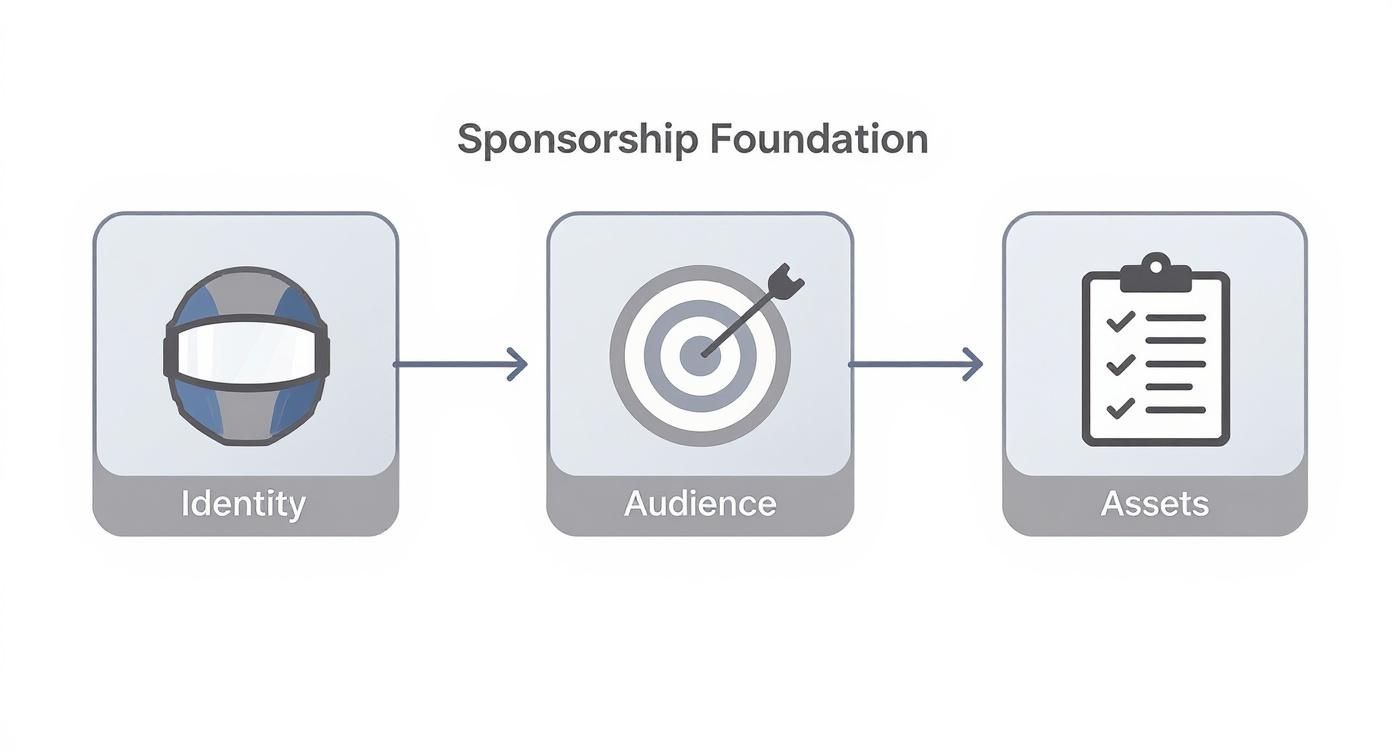
It’s a simple flow: a strong identity pulls in a specific audience and that audience becomes the valuable asset you offer to sponsors.
The Essential Sponsorship Deck
Your sponsorship deck, usually a PDF or a slide presentation, is the heart of your proposal. It needs to be visually sharp and easy to scan. Forget huge walls of text. Use powerful images, bullet points and clean headings to walk them through your story.
A deck that actually gets results will always include these key bits:
- Executive Summary: This is your one-page elevator pitch. It has to grab their attention from the first sentence. State who you are, what the opportunity is and why you're a perfect match for their brand.
- About the Team/Driver: Now you tell your story. Talk about your history, introduce the key people and share your mission. This is where your passion and personality need to come through loud and clear.
- Audience Deep Dive: Time to show your work. Present all that detailed audience data you’ve pulled together. Use simple charts and graphics to show demographics, interests and social media analytics. This is the proof that you can connect a brand to their ideal customers.
- The Opportunity: Get straight to the point. Clearly lay out what you're asking for and more importantly, what they get in return. Always frame this around their marketing goals, not your need for funding.
Structuring Your Partnership Tiers
In sponsorship motorsport , one size rarely fits all. Just throwing a single, massive number at a potential partner is a good way to scare them off. A much savvier approach is to create tiered packages. This lets brands get involved at a level that actually works for their budget and what they’re trying to achieve.
The UK motorsport scene follows the global pyramid model pretty closely. At the very top, you have 'Title Partners' who get their name plastered everywhere, often becoming part of the team name itself. We're talking fees that can top £20 million a year for the big F1 teams. A step down, 'Principal Partners' and 'Official Partners' get prime spots on the car and driver suits, with deals usually in the millions. Then you have the Official Suppliers and Technical Partners, who provide vital gear or services in return for branding and B2B networking. You can get more of a feel for how these deals come together by exploring some winning strategies in motorsport partnerships.
Building tiers makes your proposal far more approachable and dramatically ups your chances of getting a signature.
"Offering tiered packages is a strategic move. It transforms a simple 'yes' or 'no' question into a conversation about 'which level works best for you?' This simple shift in framing can dramatically improve your success rate."
To give you a clearer idea, here’s a look at how you might structure your own packages.
Sponsorship Tier Examples and Typical Inclusions
This table breaks down some common sponsorship tiers, showing how the value and deliverables scale up with the investment. Use it as a starting point for building your own customised packages.
| Sponsorship Tier | Typical Investment Range (£) | Key Deliverables |
|---|---|---|
| Official Supplier | £5,000 - £25,000 | Small logo placement on car/transporter, social media mentions, 2x hospitality passes per season, B2B networking access. |
| Official Partner | £25,000 - £100,000 | Medium logo on car (e.g., side pods, wing endplates), logo on driver suit, dedicated social media campaign, 4x hospitality passes, track day invitations. |
| Principal Partner | £100,000 - £500,000+ | Large, prominent logo on car (e.g., airbox, rear wing), major logo on all team apparel, driver appearances, full digital activation rights, exclusive sponsor events. |
| Title Partner | £500,000 - £20 Million+ | Naming rights for the team (e.g., "[Sponsor] Racing"), primary branding on all assets, full media integration, bespoke activation programme, board-level access. |
Remember, these are just templates. The real magic happens when you tailor these deliverables to solve a specific problem for the brand you're pitching.
Assembling Your Media Kit and Video
Beyond the deck itself, a couple of other assets can make your proposal truly stand out. A dedicated media kit gives journalists and sponsors instant access to key info, while a killer promo video can bring your story to life like nothing else.
Your media kit should be a clean, professional PDF containing:
- High-Resolution Images: Action shots from the track, professional headshots of the driver/team and clear photos of the car.
- Key Statistics: Your social media follower counts, engagement rates and website traffic. Keep it simple and impactful.
- Past Media Coverage: Got any good press? Link to articles, interviews or features you’ve been in.
- Contact Information: Make it incredibly easy for them to know who to call or email.
Finally, do not underestimate the power of a great video. A punchy, 60-90 second promo video can capture the energy, speed and passion of your team in a way that static documents just can't. It should be packed with on-track action, behind-the-scenes moments and a clear call to action.
Honestly, that one video might be the thing that lifts your proposal out of the pile and gets you that all-important first meeting.
Putting a Price on Your Potential and Finding the Right Partners
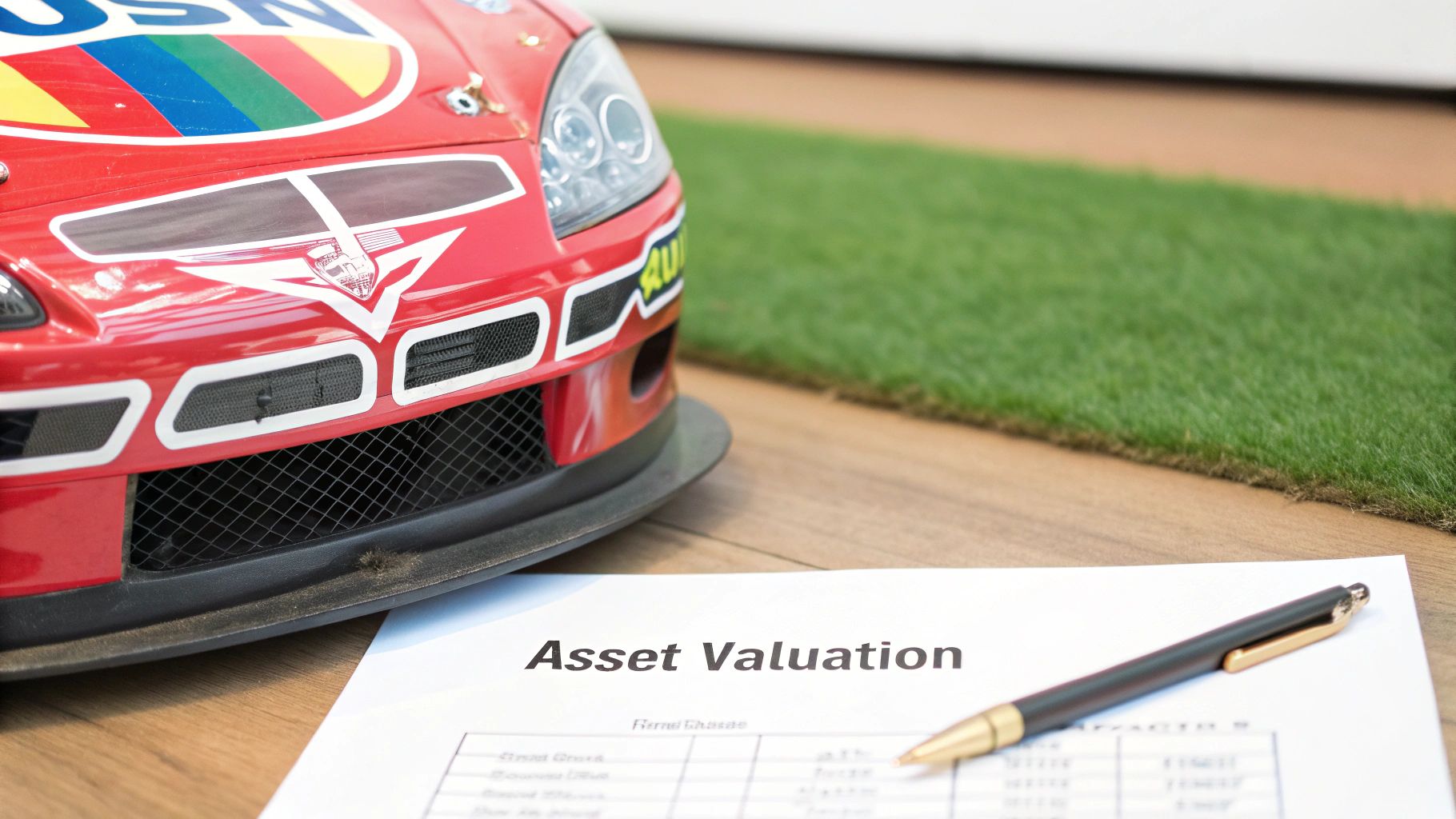
Putting a price tag on your sponsorship assets can feel like a shot in the dark but it’s a vital step that needs a proper, methodical approach. How much is a logo on the wing really worth? Answering that question is the secret to building proposals that get taken seriously and negotiating from a position of strength.
You have to shift your thinking from just covering costs to demonstrating the real marketing value you offer. This means putting a realistic monetary figure on every single asset you have, from the prime real estate on your race car to a series of sponsored Instagram posts.
Demystifying Sponsorship Valuation
Valuation is a mix of art and science. It's about calculating the media exposure a brand gets then adding the less tangible—but equally powerful—value of being associated with your team. A great starting point is to benchmark against similar teams or drivers in your series, if you can get your hands on that data.
Another solid method is using a Cost Per Mille (CPM) model, which means "cost per thousand impressions". This works especially well for your digital assets. For physical branding on the car, you can estimate viewership from race attendance and broadcast figures to calculate an equivalent media value.
Think about your assets in these distinct categories:
- Primary Branding: This is your most visible space—the bonnet, side pods and rear wing. These spots command the highest prices because they get maximum television and trackside exposure.
- Secondary Branding: Think logos on driver suits, team gear, the transporter and pit garage walls. While not as front-and-centre, they offer consistent brand visibility all race weekend.
- Digital Activation: This is everything from sponsored social media posts and website banners to mentions in your email newsletter. These are highly measurable and offer direct engagement with your fanbase.
- Experiential and B2B: This is where you offer things like trackside hospitality, driver appearances and exclusive "behind-the-scenes" access. The value here is in creating unforgettable experiences and opening doors for business relationships.
Valuing your assets isn’t just about counting eyeballs; it’s about proving ROI. A sponsor needs to see a clear line from their investment to their marketing goals, whether that’s brand awareness, lead generation or customer loyalty.
Once you have a price list for individual assets, you can bundle them into the tiered packages we talked about earlier. This creates a logical foundation for your pricing and makes your proposal much easier to defend when it’s time to negotiate. To get a better feel for what potential partners are actually looking for, have a read of our guide on the 10 marketing things sponsors want to see before handing over money .
The Strategic Art of Sponsor Prospecting
With your valuation sorted, the game shifts to finding the right partners. Firing out generic proposals is a complete waste of everyone's time. The most successful way to secure sponsorship motorsport deals is through smart, targeted, research-driven prospecting.
The aim is to pinpoint companies whose marketing objectives and target audience align perfectly with your own. Start by creating an ideal sponsor profile. Ask yourself: what kind of company would benefit most from getting in front of my specific fanbase?
Despite the UK's rich racing heritage, there's a real lack of recent, public stats on the total value of motorsport sponsorship deals here. Globally, though, the picture is huge—Formula 1 alone is expected to pull in over $2.9 billion by 2025 . Closer to home, series like the British Touring Car Championship (BTCC) attract major deals by giving brands exposure to a passionate UK audience, all within a motorsport ecosystem supported by over 720 clubs and 30,000 licensed competitors . You can find more on this over at BlackBook Motorsport.
This shows there are opportunities at every level. The key is finding the right fit. Research potential sponsors by digging into their current marketing campaigns, their company values and any previous sponsorships. A brand that already spends money in sports marketing is a much warmer lead than one that’s never done it before. This focused approach means that when you finally make contact, you’re offering a relevant, compelling opportunity, not just another cold pitch.
Getting the Conversation Started: Outreach and Negotiation
You’ve got a killer proposal and a hit list of potential sponsors. Great. Now comes the hard part: making contact and turning that initial chat into a signed deal. This is where your persistence and professionalism really count. Honestly, just getting your pitch in front of the right person can be the toughest hurdle in the whole sponsorship motorsport game.
That first touchpoint has to be sharp. Forget about blasting out generic, copy-paste emails—they get deleted instantly. Every single message needs to be personalised for the company and if you can find them, the actual person you’re emailing. A bit of digging on LinkedIn to understand their role goes a long way. It shows you've actually done your homework.
When you're trying to get a foot in the door, your first message is everything. It's worth looking at how others do it well. For instance, studying some solid blogger outreach email templates can give you a feel for what works. The core principles are the same: a strong opening hook, a clear explanation of the value and a simple call to action.
The Perfect Outreach Email
Think of your first email as your digital handshake. It needs to feel professional but still carry the energy and passion of motorsport. And keep it brief. Decision-makers are busy and they'll thank you for getting straight to the point.
A simple structure that cuts through the noise:
- An un-ignorable subject line: Be specific and make them curious. "Sponsorship Opportunity" is boring. Try something like, "A Motorsport Partnership to Reach [Sponsor's Target Audience]".
- A personal opening: Mention something specific to their company. A recent campaign you admired, an award they won, a new product. It instantly proves you're not just another spammer.
- The value proposition: In one or two sentences, spell out the unique marketing opportunity you offer and how it aligns with their brand. This is all about their potential ROI, not your need for funding.
- A simple call to action: End with a low-commitment next step. Suggesting a "brief 15-minute call next week" is much easier to say yes to than asking them to read your entire proposal right away.
And don't forget the follow-up. It's just as important. If you don't hear back in a week, a polite nudge is perfectly fine. I usually follow up two or three times over a few weeks before moving on. There's a fine line between persistence and pestering, so tread carefully.
Talking Terms: The Art of Negotiation
Once you’ve landed a meeting, the real conversation starts. This isn't about winning or losing; it's a collaborative effort to find an agreement that works for everyone. Walk into that room confident in the value you've calculated for your assets.
Be ready for pushback. You'll hear things like "the budget is too high", "the timing isn't right" or "I don't see the fit". Don't get defensive. Listen and ask questions to figure out what their real concern is.
Your goal in a negotiation is not to 'win' but to build a partnership. If a sponsor feels they've been pushed into a corner, the relationship starts on a weak foundation. Aim for a deal where both sides feel they have achieved a great result.
If the price is the main issue, get creative. Can you adjust the deliverables? Maybe swap a premium logo position on the car for more digital content or a few extra driver appearances. Showing flexibility proves you’re a genuine partner, not just a salesperson.
Sealing the Deal: Get It in Writing
When you finally shake hands on an agreement, the very next step is to get it all down in a formal contract. This is non-negotiable. A proper contract protects both you and the sponsor by making sure everyone is crystal clear on who is doing what, when. It's always a smart move to have a solicitor, preferably one with commercial experience, give it a once-over.
Your contract must clearly outline:
- Term: How long the partnership will last (e.g., one full race season).
- Payment Schedule: The exact amounts and due dates for every payment.
- Deliverables: A complete, detailed list of every single asset and service you're providing.
- Exclusivity: A clause clarifying if they are the only sponsor from their industry.
- Termination Clauses: The specific conditions under which either party can end the agreement early.
A solid contract is what turns a hopeful handshake into a professional, legally-sound partnership. It’s the foundation for a successful and hopefully, long-lasting collaboration.
Delivering and Measuring Sponsorship Value
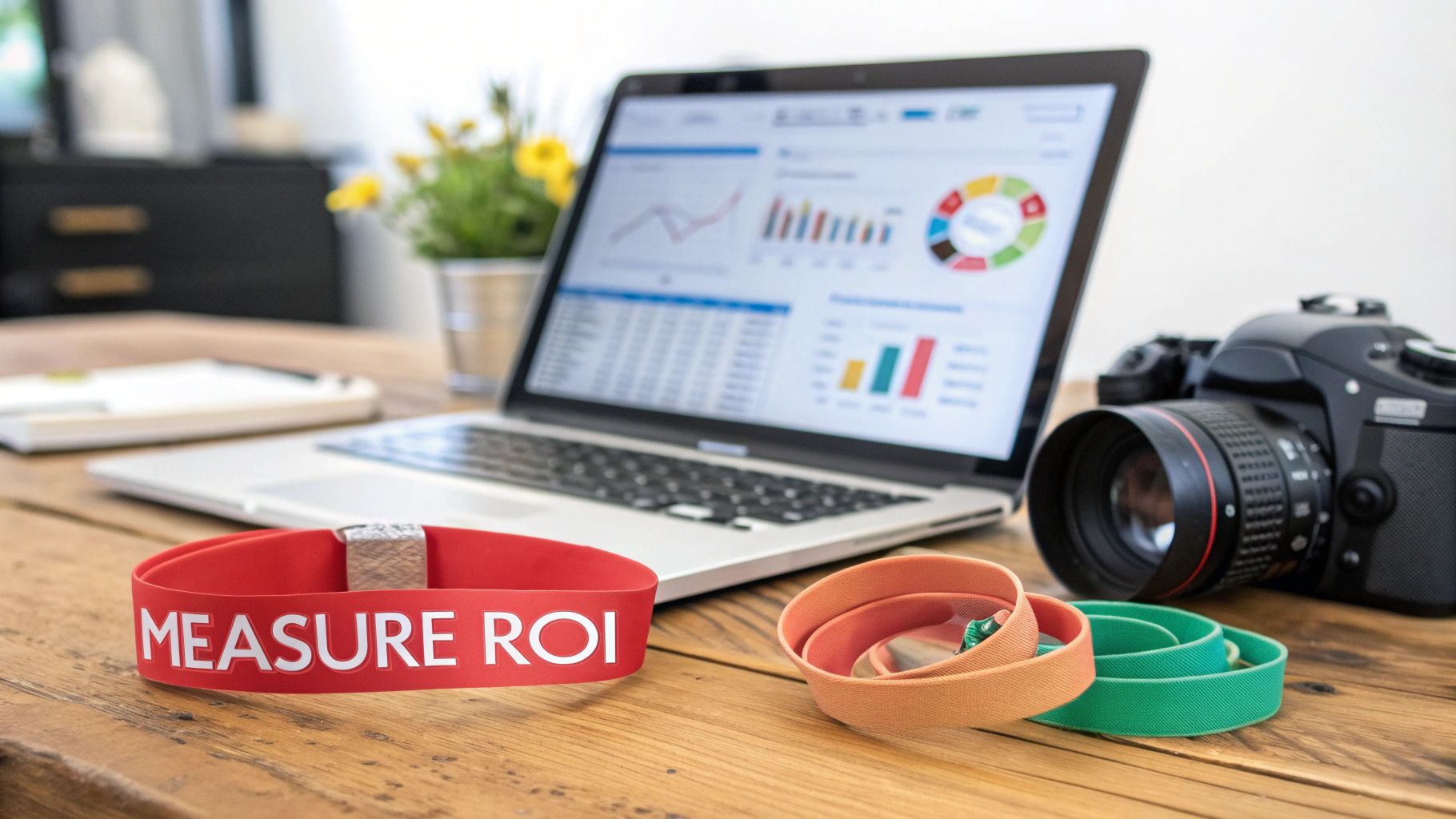
Getting that signature on a sponsorship deal is a massive win but it’s just the starting line. The real work begins now.
Delivering exceptional value is what turns a one-season deal into a long-term partnership. That means going way beyond just slapping a sticker on the car. This is the activation phase—where you bring the partnership to life by creating memorable experiences and crucially, measurable results that prove your sponsor made the right call. Forget passive branding; modern sponsorship motorsport is all about active engagement.
Creative Activation Ideas That Deliver
To really cut through the noise, you need to get creative with how you weave your sponsor's brand into the race weekend and your digital presence. The aim here is to build genuine, authentic connections between the sponsor and your audience.
Here are a few ideas to get the wheels turning:
- Exclusive Trackside Hospitality: Offer a premium, money-can't-buy experience. This isn’t just about handing out tickets; it’s about giving your sponsor's guests a proper ‘behind the velvet rope’ look at the team. Think exclusive garage tours, Q&A sessions with the driver and engineers and top-tier catering with a prime view of the track.
- Collaborative Digital Campaigns: Team up with your sponsor to create co-branded content. This could be anything from a video series documenting your journey to a race, a 'day in the life' social media takeover on their channels or a competition where fans can win signed merchandise.
- Show Car Activations: This is a classic for a reason. Arrange for your race car to be displayed at your sponsor’s headquarters, a major trade show or a key retail location. It's a powerful tool for grabbing attention and letting staff and customers get up close with the machinery.
A huge part of delivering value is creating promotional materials that actually make an impact. Using a step-by-step guide to creating effective video ads can seriously maximise a sponsor's visibility and engagement, making the partnership feel tangible for everyone involved.
Setting Clear KPIs from Day One
You can’t prove the value you’ve delivered if you haven't defined what success looks like from the start. Before the season even kicks off, you absolutely must sit down with your sponsor and agree on a clear set of Key Performance Indicators (KPIs) . These are the specific, tangible metrics you'll use to measure the partnership's impact.
Your KPIs need to be tied directly to what the sponsor wanted to achieve in the first place. Vague goals like "increase brand awareness" just won't cut it. You need to get specific.
"If you can't measure it, you can't improve it." This old business saying is the golden rule of sponsorship. Hard data is what justifies budget renewals, not just good feelings.
Common motorsport sponsorship KPIs include:
- Media Value Equivalent (MVE): The calculated monetary value of the exposure your sponsor gets from TV broadcasts, online articles and print media.
- Social Media Engagement: Tracking the hard numbers—reach, impressions, likes, shares, comments and follower growth on any co-branded content.
- Website Traffic: Measuring referral traffic from your platforms to the sponsor’s site using unique, trackable links (like UTM codes).
- Lead Generation: Using unique discount codes or dedicated landing pages to track how many direct leads or sales the sponsorship actually generates.
Defining these metrics upfront ensures everyone is on the same page and gives you a clear framework for your end-of-season reporting.
Compiling the End of Season Report
As the season winds down, your final job is to pull together a comprehensive report showcasing everything you’ve delivered. This document is your proof of performance and your most powerful tool for securing that all-important renewal. It needs to be a professional, data-rich summary of the partnership's success.
The UK’s motorsport industry contributes around £10 billion to the economy each year, which speaks volumes about the sector's scale and commercial power. With Formula 1 alone reaching a global TV audience of over 1.5 billion , the exposure opportunities are immense. Using figures like these helps to contextualise the value you're providing.
Your report should present the KPI data in a clear, visual way using charts and graphs. But don’t just dump the numbers on them; tell the story behind them. Explain what worked well, shine a light on key successes and offer insights that can help shape the strategy for next year. A solid grasp of how to measure ROI is a fundamental skill for UK marketers and is non-negotiable for proving your worth.
By meticulously tracking performance and presenting a compelling, data-backed report, you demonstrate professionalism and a clear return on investment. This changes the renewal conversation from a new sales pitch into a simple continuation of a partnership that just works.
Here are some of the most common questions we get from drivers and teams trying to navigate the sponsorship maze. Getting this part right is crucial, so let's clear up a few things.
How Much Sponsorship Should I Ask For?
This is the big one, isn't it? The key is to stop thinking about what you need and start thinking about what you can offer. Simply asking a company to fund your entire season's budget is a rookie mistake.
Instead, your 'ask' must be grounded in the commercial value you can prove you deliver. We broke this down earlier in the valuation section but it boils down to this: calculate your total costs then work backwards to create tiered packages based on what your assets are actually worth to a business.
It’s far more professional to present a sponsor with a £50,000 package that clearly outlines their return on investment than it is to just ask for £50,000 to go racing. One is a business proposal; the other is a donation request.
Should I Accept Product-Only Deals?
Sometimes called 'value-in-kind' sponsorship, these deals can be a lifeline, especially when you're starting out. A company might offer essential gear like tyres, tools or safety equipment instead of cash. While it won’t cover your entry fees, it can take a massive chunk out of your overall budget.
A product deal is often a foot in the door. Prove you can deliver fantastic value for a supplier and they’ll be far more open to a cash conversation next season. It's how you build a track record.
The golden rule here is to treat a product sponsor with the exact same respect and professionalism as a cash partner. Deliver on every promise, give them a brilliant end-of-season report and you’ll lay the foundations for a much bigger partnership down the line.
What If a Sponsor Says No?
Rejection is just part of the game. Don't take it personally. Most companies are swamped with sponsorship requests and a 'no' can come for a dozen reasons that have absolutely nothing to do with you. It could be a budget freeze, a recent shift in marketing strategy or just bad timing.
When you get turned down, always respond politely. Thank them for their time and consideration. If it feels right, ask if they’d mind if you kept them on your mailing list for future opportunities. It keeps the door ajar and maintains a positive connection.
Persistence is everything. For every ten rejections, you might just get that one conversation that turns into a race-winning deal.
Ready to stop chasing and start building partnerships that drive real results? Superhub is a specialist motorsport marketing agency that lives and breathes the commercial side of the sport. We build data-driven strategies that connect teams and drivers with the right sponsors. Find out how we can fuel your growth at Superhub.

